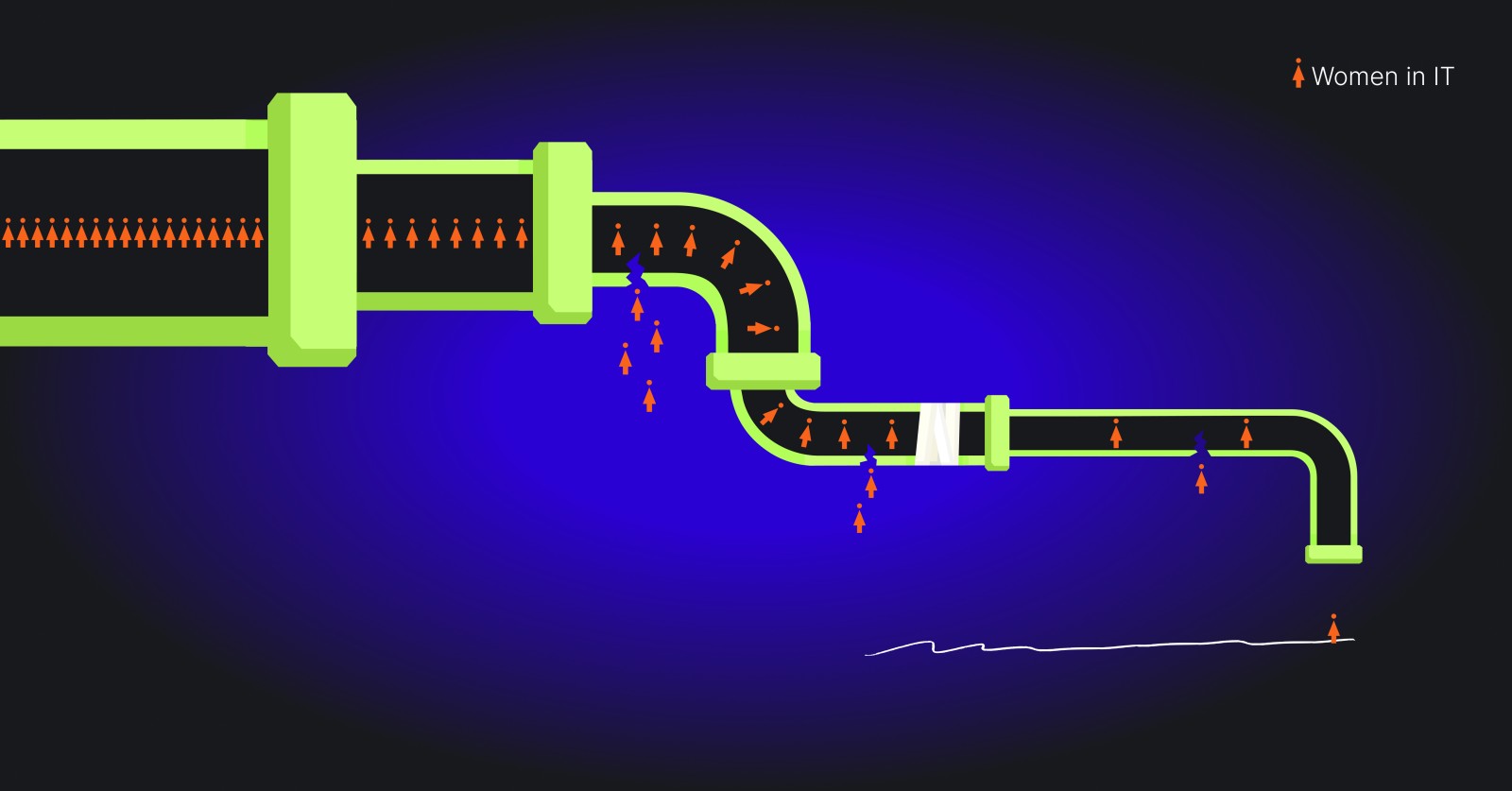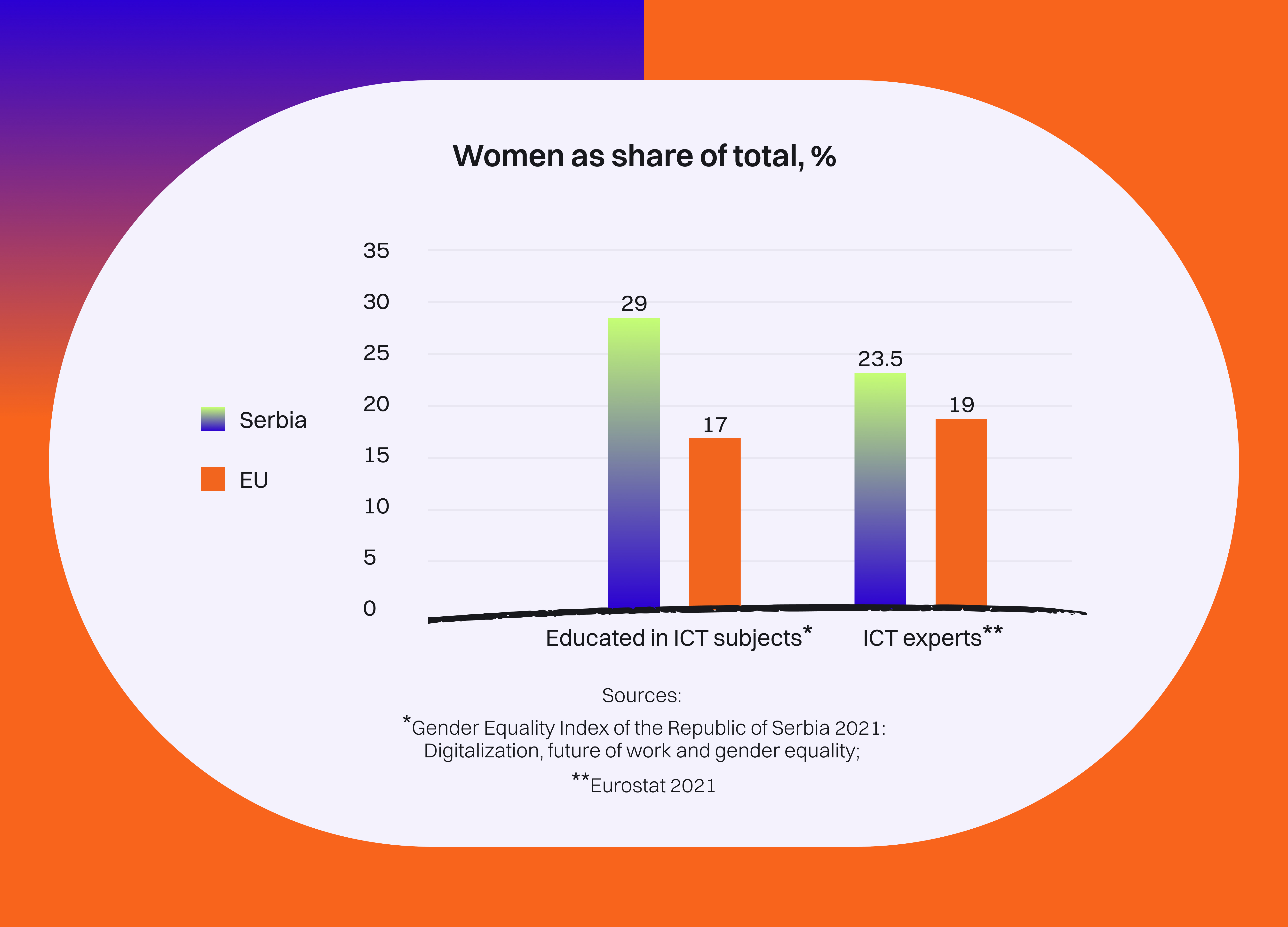How Can Women Become Winners of the Fourth Industrial Revolution?
A Hurdle Marathon
January 20, 2023

Leaky pipeline phenomenon
We live in the age of the Fourth Industrial Revolution which is rapidly transforming the economy and our way of life. Artificial intelligence, automation and robotics are increasingly widespread in different sectors. In some places, they are already replacing humans as workforce, as the example of automated cash registers in supermarkets shows. In parallel, new technologies make complex tasks, such as analyses of big data, much easier.
This revolution brings a major opportunity for social and economic development, but also the risk of increasing already existing inequalities. For example, in the professions related to the STEM (science, technology, engineering, mathematics) fields, which provide the workforce of the Fourth Industrial Revolution, there is a significant disparity in the share of men and women.
Bearing in mind that STEM professions, and especially the sector of information and communication technologies (ICT), are among the fastest growing areas of labour, with high earnings, we believe that it is necessary to secure the equal representation of women and provide them with fair conditions for dignified work and ability to progress in their careers.
How women “disappear” from STEM fields?
Compared to the women in the EU, more women in Serbia enrol and graduate in STEM subjects. – Female students represent 29% of the total number of ICT students, as opposed to 17% in the EU, and their share in the number of ICT employees is also higher – 23.5% in Serbia versus 17% in the EU. However, women are less represented in the leading positions and key jobs in this industry, such as chief executive officer (CEO), or chief technology officer (CTO).

Furthermore, women who were trained and found employment in STEM fields leave the labour market or work on lower paid positions, instead of advancing. This dissipation is noticeable from the very beginning of their careers and is first reflected in the fact that the number of women who work as ICT professionals is smaller than the number of women who were trained in this field. The gap between men and women is more and more pronounced as we progress towards top managerial positions. This phenomenon is known as “leaky pipeline”.
Women leaders of the “revolution”
As we are aiming for equality between men and women at all levels of education and work in STEM fields, we believe that it is important to find the answer to the following question: what makes talented and successful girls and women opt for other careers after finishing their education in STEM fields, and what prevents them from advancing in the IT sector on par with their male colleagues?
We sought answers from women with experience in STEM fields, in different professional positions and different roles – from leading positions in private and public sector IT companies, women’s rights activists and advocates, teaching assistants at the Faculty of Electrical Engineering in Belgrade, to primary school computer science teachers. Besides their stories, we also used alternative data sources (e.g. LinkedIn data analysis), so that we could understand the situation beyond just the numbers.
We gathered around thirty women for a one day workshop in order to find out what motivated them for education and work in STEM fields, what kind of obstacles they encountered, how they overcame them, and what was the source, if any, of the support that helped them endure and succeed as women in STEM.
“Boy’s Club” from the earliest age
Workshop participants listed numerous obstacles and challenges that they, or other girls and women from their environment, encountered from their childhoods onwards. In some cases, it was the lack of understanding or material resources in the family, that resulted in the insufficient support for girls to educate themselves in STEM fields. The participants also noted that differences in upbringing of boys and girls have impact on further choices in life: “Boys are encouraged to climb a tree, while girls are told – Watch out! You’re going to fall, and rip your dress and get dirty.” This is one of the examples of how curiosity and trying out new things is not stimulated equally for boys and girls: “Later in life, women find failure hard to take in, so they frequently give up, while boys are rewarded for their courage and dare.”
When choosing a faculty, even though they were showing talent and interest for sciences, some of the workshop participants received discouraging messages from their immediate environment: “Why would you torture yourself, study something easier”, or: “You can’t avoid house work, better choose an easier line of work.”
Finally, as adult women, they encountered the social perception that women should prioritize family obligations, not career. They also noticed another important prevailing opinion – that women are not the economic pillars in families. They believe that such social attitudes discourage women from aiming for challenges and career opportunities.
There are also many obstacles in the professional environment. The examples range from the company culture which does not suit the needs and interests of women, such as selecting football as team-building activity, to work spaces which do not cater to the needs of women, such as offices without separate toilets for men and women. Some of the participants even shared with us that they had witnessed sexual harassment or sexist culture in their professional environment.
Finally, they all agreed that the ICT sector, from a women's perspective, still represented a “boy’s club”.
How did they manage to become and stay members of the club? In short – they were courageous and persistent in following their interests and ambitions. They listed different types of informal education, competitions at the faculty, even access to “engineering” toys as motivating influences that helped them in their careers. Additional support on their path towards success in STEM has been provided by their successful colleagues, both men and women. Additionally, all these women are exceptionally intelligent, persistent, courageous and dedicated.
How to get more women into STEM?
Our wish is to make women's success in STEM the norm rather than the exception.
It is therefore necessary to build environments in which the women who are already successful in STEM fields would be more visible and serve as role models to girls so that they would more daringly and commonly opt for education and professions in these fields. This would contribute to breaking stereotypes of desirable professions for men and women.
As women make somewhat more than a half of the total population, their bigger representation in the IT would be useful for the very industry with its ever increasing need for workforce. Simultaneously, a more evident presence of women would help services and products become adapted to the needs of both men and women, which would improve users’ trust.
Inclusion of women in this segment of economy, but also a general increase in the “IT literacy” of women, would help women become more independent economically. This is beneficial for the entire society, because more economic security and independence for women would directly impact the rates of violence against women, as well as decrease poverty related risks throughout women’s lives.
In the following period, UNDP and Accelerator Lab will implement a number of research initiatives related to women in STEM fields. We will use alternative sources of data, as well as personal stories of women, so that we could also understand the aspects that remain elusive when observing only statistical data.
Together with different actors from all sectors and different industries – from school teachers and state institutions’ actors, to corporate IT managers – we intend to help women in choosing and keeping well-paid jobs, and crash the invisible barriers to equal distribution of power in the society. In this way, we aim to actively contribute to the creation of a society in which women can become winners of the Fourth Industrial Revolution.

 Locations
Locations